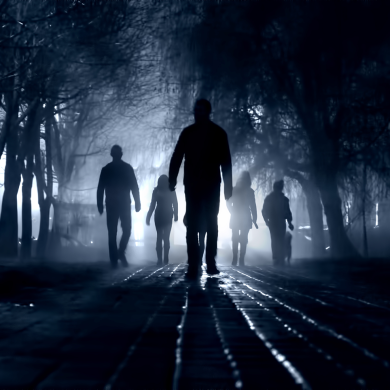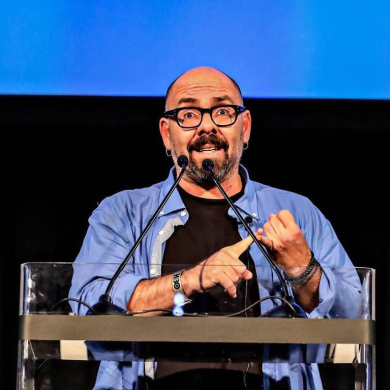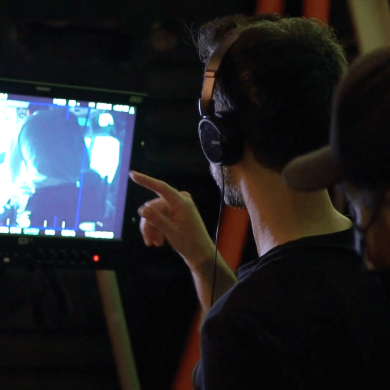By Justin Sanders
The talented individuals behind film festivals tend to be able to spot a good submission a mile away, but when Slamdance Film Festival President Peter Baxter first laid eyes on the work of Japanese animator Shunsaku Hayashi, he knew he had something that was more than good.
“I felt transported into Shunsaku’s dream-state of being,” Baxter told CreativeFuture. “He has an exquisite feel for color and composition. There is a sense of being alive and separate from others, the pain of that as well as the freedom to turn inwardly and explore. It’s an aesthetic that feels of the moment but doesn’t follow any trends. It’s like seeing humanity from above.”
Strong words, but it’s hard to argue with them after watching a film like Shunsaku’s Railment, a 10-minute descent into the psyche of a lonesome train passenger that is as beautiful as it is alienating. Full of wispy human automatons and eerie subterranean backdrops, the film gets its singularly haunted look from a mixed-media approach Shunsaku calls “painted animation,” which entails digitally capturing the same canvas over and over again, physically altering the painting in each new frame with photography and other materials.
“Since I was young, I always enjoyed mixing several different kinds of media in one frame, inside the frame,” Shunsaku told CreativeFuture. “I want to enjoy some accidents along the way, some grit.”
Painstaking and often stunningly elaborate, it’s an exploratory, improvisational process in which viewer and artist are complicit in the same voyage of discovery. In the case of Railment, it was also novel enough to win Shunsaku the inaugural CreativeFuture Innovation Award at Slamdance 2018. He also took home the event’s Grand Jury Prize for Animation Short.
“With Shunsaku, we see different forms of expression made possible,” Baxter said. “A unique artist emerging into our consciousness. That’s really exciting for us and that’s the type of artist we want to support.”
With other films such as Down Escalation and Interstitial currently making the rounds, Shunsaku’s works have also appeared in festivals ranging from the Palm Springs International Film Festival to Filmfest Dresden in Germany and the Melbourne International Film Festival in Australia.
When he spoke with CreativeFuture from his home studio in Osaka, Shunsaku had just arrived back from an American tour that took him from the Ann Arbor Film Festival to Colorado for a three-week arts residency in animation, and then to Atlanta for yet another fest.
“I came back three days ago,” he said, “so I still have jet lag.”
JUSTIN SANDERS: When did you first know you wanted to be an artist?
SHUNSAKU HAYASHI: My father used to be a painter so I started painting when I was 3 or 4 years old. At the age of 10 I was introduced to the films of Jan Švankmajer, and after that, I just wanted to do animation.
JS: Who is Jan Švankmajer and why did you find his films so inspiring?
SH: Jan Švankmajer is a Czech animator. When I was young, I didn’t understand what he was trying to say and what the meaning of the political metaphors in his films was – I was just inspired by his aesthetics. He used puppet and painting animation, as well as some live action, and he mixed everything together and I was inspired by his very unique expression. I had no idea about animation until I saw Švankmajer’s work.
JS: Once that fire was lit, how long did it take you to start doing animation?
SH: I started it when I was 12, just a few days after I first saw work by Švankmajer. My first try was puppet animation. I made a puppet with paper clay and drew a background on a spread notebook.
Later on, I went to the United Kingdom to study contemporary art at the University of London and started making experimental film.
JS: Why did you go to London to study art?
SH: The first reason was just to get out of Japan. A Japanese artist I respect named Shinro Ohtake had spent some time in the U.K. when he was 19, so I thought I should do the same thing when I became his age.
Also, at the time my painting was more pop, and I wanted to make a change but I didn’t have any contemporary art background. I wanted to do something different, and so I decided to go to London.
JS: How did your style evolve into something different while in London?
SH: By the time I graduated from college there, I found myself wanting to explore some intersection between painting, experimental film, and animation. Since I was young, I always enjoyed mixing several different kinds of media in one frame – inside the frame.
I now use a more traditional handmade animation style with digital processing. I use frame-by-frame animation and I draw on paper. I never use any 2D digital animation. I still use digital processing, but I draw or paint by hand to actually produce each frame.
JS: Why do you prefer to create the frames physically by hand? Isn’t there technology that lets you still draw or paint, but with a digital implement?
SH: People say it’s easier to make digital animation, but I want to make film as a painter. For me, physical painting and drawing is my favorite part, so I won’t do it in digital.
I also don’t make any illustration boards or write any scripts because I want to enjoy some accidents along the way – some grit. Hand-painting results in more mistakes – that I can control.
At the same time, I don’t want to animate with solely analogue techniques. I use a digital camera and scanner to digitize my drawings and paintings and then edit them in After Effects. I want to express the texture of hand-painting on a digital animation surface.
My process has evolved to execute this animation technique on a very large canvas – because it is a way to express texture more clearly on the screen.
JS: Did someone teach you this unusual technique?
SH: I didn’t learn anything in terms of techniques from anyone. I just created it myself.
I’m not good at being taught and I don’t like reading textbooks or watching YouTube how-to videos, so I learn through experimenting. The first few months of learning new techniques are a struggle – but exciting. I am happy that I am still learning.
JS: You came to the attention of CreativeFuture when your film Railment, a dream-like depiction of riding the train, won our inaugural Innovation Award at the Slamdance Film Festival. Can you talk about making this beautiful and unusual work?
SH: Railment was the film on which I honed my current technique. It started as a painting and I wanted to expand it to animation.
At the time, I drew all my figures, objects, and backgrounds and animated them separately, using composition tools in After Effects. But I started thinking that all these layers in After Effects were kind of like my life. I am one layer and each object and person around me is another layer, and we are together but we still have space between each layer.
I wanted to express this perception of life in the animation. I chose a train as my setting because it is a moving space where I could emphasize this idea of layers. It is a setting where you can see the background is moving, but I am not.
I tried to make some of the objects or scenery sit still. In one scene, for instance, many passengers enter the train and the train departs, but the train isn’t moving. Just the background moves. I tried to express the movement of a train without the train actually moving.
This is the whole idea of this film.
JS: The space between layers that you talk about manifests literally in Japan. One thing I found fascinating when I visited Tokyo was how, despite its immense population, I never felt cramped or crowded. No one ever jostled me. It was like there was this bubble around me wherever I went.
SH: I think you felt this space because most of the people here follow the rules. They walk at the same speed and they speak the same language and they have similar backgrounds, so their behavior comes from a common point. Their perception of space is similar.
That’s why I sometimes feel isolated on the train, or I find myself questioning my individual identity – because I’m the same as the people around me. [Laughs] I don’t like being on the train. It makes me feel depressed!
JS: The score for Railment, as well as for your other films such as Down Escalation and Interstitial, is also a huge part of the surreal journey you present onscreen. Who does your music?
SH: The score for Railment was created by Jack Stevens, a British musician who is my best friend from college in London.
For the last film and for my newest film I collaborated with Makoto Itabashi, a Japanese musician who I have known since elementary school. Sometimes I work with international people, sometimes not. I don’t care who I work with or where they come from – the important thing is that they are my friend and I like their work, and that they trust me and I trust them.
This relationship is more important than anything.
JS: I imagine you make a lot of relationships through international film festivals, where your films have played many times. How important are film festivals in terms of getting your work out into the world and networking?
SH: I’m not very self-promotional. Just the act of doing the painting and animating is much more important to me than showing my work to people. A film festival is a nice way to share work, especially for international filmmakers, and yes, I see a lot of people at them.
JS: Do you try to attend all of the festivals you get into?
SH: I wish I could, but it’s too far to go to all of them! Sometimes, from my home in Osaka, I have to take three separate flights, with two layovers, just to get to where I’m going. It can take up to 22 hours to get to a city where a festival is located!
JS: Seeing as it’s so hard to get to them, do you do any pre-planning before attending a festival, just to ensure you maximize the experience?
SH: I just try to enjoy them and find good people.
Talking with other filmmakers is very nice because my life is very quiet. I have no friends in Osaka doing film, so I don’t talk about art or film in my daily life. Most of the time I just concentrate on my work. A film festival is the only time I can meet people working on film and art.
JS: What was it like taking Railment to Slamdance, a festival that got its start as a kind of subversive alternative to the Sundance Film Festival?
SH: It is a crazy memory for me. Railment was actually my second work to show at Slamdance, and I was so excited when it got in. Attending Slamdance is tough because it requires so much time and energy to get from Japan to Park City, Utah. But the people there are very strong filmmakers and they are proud of being independent. I was very impressed by this attitude toward making work and I am so happy to have been in Slamdance for two years running.
JS: Do you support yourself financially with your filmmaking?
SH: I’m quite lucky. I won some prizes and some grants, so most of the time I just work on my films. I’m very lucky to have money and time to concentrate on my work. I don’t know about next year, but so far, I am okay.
I just want to do my best before my money runs out!
JS: Does it help you make a living to be able to put your films up online?
SH: I am afraid of showing my work on the internet. For instance, Vimeo asked to feature my work but I worried about showing it there. Another service asked me to do online distribution, but I worried about that, too. I am still thinking about how I can present my work securely in the online world.
Also, if I show my work publicly online, I don’t know how the work is consumed. Even if some people see my work and my name becomes better known, I can’t see how they are reacting to it. [Laughs] I can’t see anyone’s face, so I worry about it.
JS: What are you working on now?
SH: When I made Railment, I tried to remove all the facial expressions of the characters, so each character is a stickman, even the main character. I tried to remove all the facial expressions and features like the mouth and eyes.
Because I think anonymity is important, I am now trying to remove even the body itself. I am trying to make a narrative film without any characters or any living beings at all – a narrative structure built on just movements of water.
[Laughs] It’s quite experimental. I don’t want it to be too abstract, but I want to have narrative in the film without characters. I hope to finish it by October.
JS: What are your concerns as an experimental artist living in our current moment?
SH: Each film I make takes about 8-12 months, and during that time, so many things happen on the Earth. Sometimes I feel like, is that okay? Sometimes I feel that I should be doing something much more relevant to the present moment.
But also, I feel that because of social media, many people try to express everything for the present moment. Most people’s voice is temporary, and only sticking to the moment. But it’s important, even if it takes a year, to develop your ideas and your voice as well.
To make my art, I have to take that kind of time to develop my voice, and that is more important than talking about the here and now.
JS: I think part of what you are saying is that because self-expression has become so instantaneous and reactive, we are losing unique and powerful artistic voices, and maybe also our ability to appreciate them?
SH: For me, artwork is a kind of initiation. After I discovered Jan Švankmajer, my perception of the world became different, and I know that when I have encountered certain other films and artworks and literature and music – that my perception has become different again. That is not always a comfortable experience, but I believe that is the role of artwork.
People need more experiences encountering something different that they don’t understand, because now people are afraid of what they don’t understand, and people are afraid of people they don’t understand.
I think that experimental film or art is an opportunity for a person to practice ingesting something that they don’t understand.
JS: What advice would you have for an aspiring experimental filmmaker?
SH: Finish what you start and keep it true to yourself. I don’t share my work, take any advice, or respond to any reactions until a version of the piece is completely done.
The goal is to make small or big decisions each day that are entirely your own. I work to ensure that each decision of color, composition, pacing, timing, story, and concept is entirely my own.
When you are precise with your own aesthetics in this way, it can be thrilling. If you do not find it thrilling, then perhaps this path is not for you.
All photos courtesy of Shunsaku Hayashi



